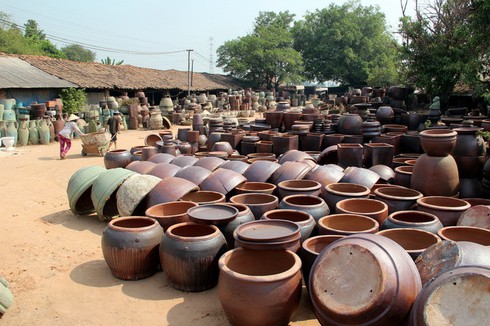Tan Van was founded about 300 years ago on the Dong Nai River near what is now Bien Hoa City. From the first pottery village, satellite pottery villages sprang up in neighboring Binh Duong province and Ho Chi Minh City.
Hong Van Chinh is one of the last remaining “modelers” of Kim Lan pottery kiln in Tan Van. Inheriting the 4-generation family craft when he was in his 20s, Chinh has become the village’s most talented modeler. His deft hands have turned handfuls of clay into jars and jugs weighing hundreds of kilos and decorated with intricate designs without using any kinds of molds or tools.
Chinh said today there are few modelers left because pottery techniques have greatly improved, especially the wide use of molds.
Not everybody can become a professional modeler, he added, “It’s easy to be a copier using an available mold. To create my own molds, I have to be keen. It takes more than a year to learn the technique. That’s for good trainees. Some people can’t learn the craft even if they study learn for years.”
To turn out the most popular products, artisans in the south’s oldest pottery village must pay attention to every detail. According to the village elders, each enamel was a family’s secret handed down from generation to generation and carefully guarded.
Products go through a baking step. Modellers make the shapes, but, “firers” determine whether or not they become quality products.
Braving the kiln’s white hot temperatures, Lam Lap, one of Tan Van’s few expert “firers”, checks the temperature every five minutes and controls the wood fuel.
Lap said there are many small doors in the kiln walls which is about one hundred meters long, through which to add more firewood. He needs to keep the kiln at 1,200 degrees Celsius for four days to bake pottery items properly. This step requires firers to understand the character of their kiln and nature of the earth and firewood.
Lap told VOV, “I began to follow the craft when I was around 20. I was told that it was the family’s time-honored craft. Now I love it very much. Those who don’t have a passion for pottery, can only do this job for a couple of years.”
Chinh and Lap don’t remember how many places batches of pottery they have made in 30 years. But all the villagers know that Bien Hoa black clay pottery used to be an indispensable part of southern life.
Today Tan Van pottery village makes the fine art pottery for export. Bien Hoa black clay pottery pieces not exported are sold to restaurants and resorts for decoration rather than in the market. This has helped Tan Van pottery village survive.




